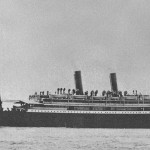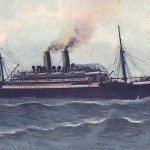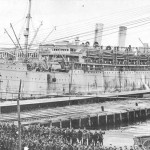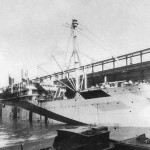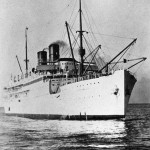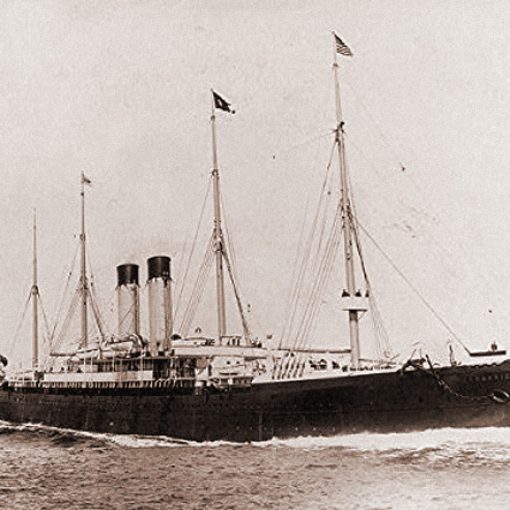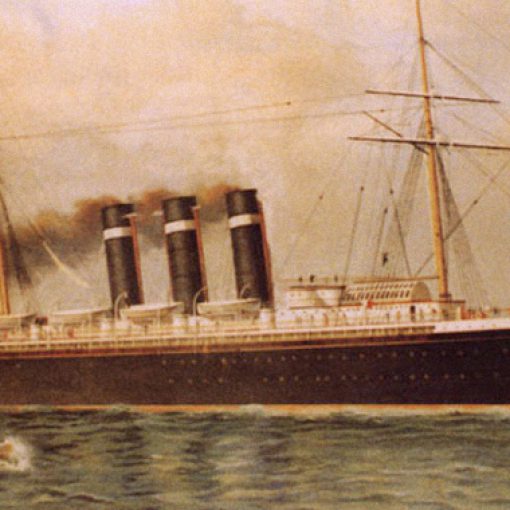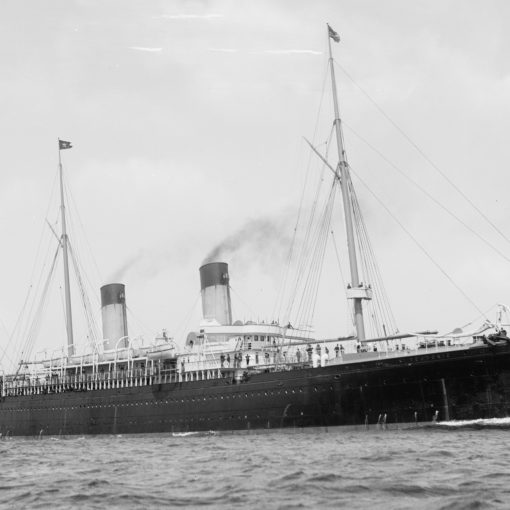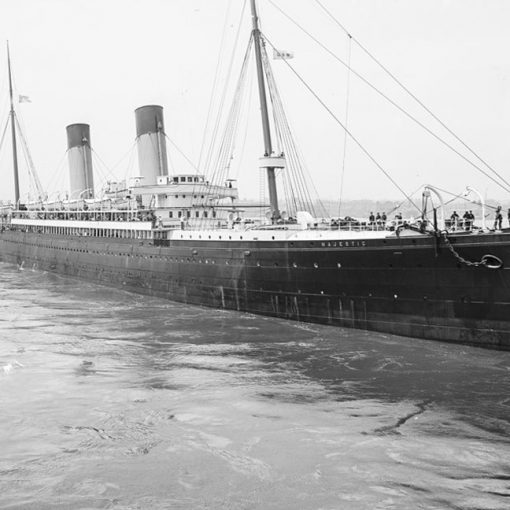1896 – 1922
Also known as City of Honolulu
The end of the 19th century saw a massive development in the shipping business. The Great Eastern – who was an astonishing 19,000 gross tons large – was built in 1860 and was the forerunner of an entirely new breed of ships. This ship was far ahead in size and accommodation compared to other liners of the time, but she became somewhat of a failure, with only a small amount of North Atlantic passengers choosing her for a crossing. People still trusted the old fashioned type of ships like the French Line’s Washington or Impératrice Éugenie.
The breakthrough for great liners did not come until the late 1880s. The Inman & International Line’s City of New York was the first liner to exceed the 10,000 gross ton mark since the Great Eastern. She and her similar sister City of Paris entered service in 1888 and 1889.
In 1889 the British White Star Line also aimed for size when they put the 9,000 gross ton large Teutonic into service along with her equally large sister Majestic the next year. These two ships were not the largest in the world, but they were built with speed in mind. It would not take long before both the Teutonic and the Majestic had kept the Blue Riband for some time.
During her first year of service, the Teutonic attended the Spithead Naval Review in England to show the world how dominant Britain was on the sea. Among the guests was the German Kaiser Wilhelm II who eyed the Teutonic with interest. He was impressed by her size and speed, just as he fancied the luxurious interiors. He is said to have remarked ‘We must have some of these’.
One of the first things the Kaiser did when he returned to Germany was to urge the country’s shipping lines to create ships of the Teutonic’s calibre. The two dominant shipping lines in Germany at the time were the Norddeutscher Lloyd and the Hamburg-Amerika Linie. Norddeutscher Lloyd took the first steps in helping Germany to dominate on the seas when they placed an order for a ship at the Vulcan Shipyards in Stettin in 1895. This ship would be the largest Germany had ever managed.
On August 1, 1896, the new ship was launched and christened Friedrich der Grosse in Stettin. The fitting out commenced immediately afterwards and the ship had her quadruple expansion engines installed which were geared to two propellers. This combination would make the Friedrich der Grosse capable of maintaining a service speed of 14.5 knots. This certainly did not make her the fastest ship on the seas, but the distinction of being the largest German ship attracted lots of patriotic Germans.
The Friedrich der Grosse was completed on November 11 that year, and was ready for her maiden voyage about a week later. Her first crossing went to Australia where many ships were needed during this time due to the massive emigration. The Friedrich der Grosse did not have a strict schedule on where her permanent route was supposed to be, and she was used either on the Australian run or on the North Atlantic, depending on where she was needed.
The culmination of Germany’s answer to the Teutonic came in 1897 when the Kaiser Wilhelm der Grosse was commissioned. This ship was the fastest and largest in the world at the time. She had taken the Blue Riband from Cunard Line’s Lucania with an average speed over the Atlantic of over 22 knots. The British had been totally outmanoeuvred. Not until two years later did they manage to produce a larger ship. The White Star Line’s Oceanic was the largest of the time, but she had no chance in acquiring the Blue Riband from the Kaiser Wilhelm der Grosse with a service speed limited to 19.5 knots. Britain continued to produce large liners well into the 20th century, but no ship came close the Kaiser Wilhelm der Grosse’s speed.
With these new ships in mind, Norddeutscher Lloyd felt that they needed to update some of their old liners to keep them attractive for passengers. In 1902 the Friedrich der Grosse went out of service temporarily in order to be slightly refitted. After the reconstruction, which was completed the same year, the ship emerged with an impressive 10,696 gross tons compared to the 10,531 gross tons the ship had had when she entered service.
Two years later, World War I broke out when Germany and Britain finally got into war with each other after decades of building-up hate. The actual moment when the war started could not have been worse for Germany. All too many of the countries merchant ships were in American ports, and most of them were interned in the United States within short. Among these liners were Germany’s latest achievements – the Imperator and the Vaterland, both over 50,000 gross tons. The Germans felt it would be a safe place for their ships since America had not yet entered the war. Just as her larger country mates, the Friedrich der Grosse was interned in the US.
But as the Germans became worse and worse in their way of handling the war, America seemed to sympathise with the British-French side more and more. The German ruthlessness culminated in 1915 when a German U-boat torpedoed and sank the British passenger vessel Lusitania with a loss of close to 1,200 lives. After two more years of provocation, the United States Senate voted to go to war against Germany. With this, all the German ships in American ports were seized by the US Navy.
The Friedrich der Grosse was officially seized on April 6, 1917. She was transformed into a troop transport and shipped American soldiers to Europe, bearing her new military name Huron. The Huron continued with this war duty until the end of the war. Since the Germans had lost, none of her ships were returned to them. The Huron was taken over by the US Shipping Board in 1919, who had the ship refitted into an oil-burner by Morse, Brooklyn. The Shipping Board kept the ship for another three years, when she was chartered to the Los Angeles Steamship Company, and renamed City of Honolulu. The ship was put on the Hawaiian service.
On October 12 the same year, the City of Honolulu was 400 miles from Los Angeles on a return voyage from Honolulu when she suddenly caught fire. The fire spread so quickly that the passengers and crew had to leave the ship on to other nearby vessels. The City of Honolulu stayed afloat until the fire was out, but she was nothing but a burnt-out shell. Five days later the US transport Thomas arrived at the scene with orders to sink the ship. The remains of this once so impressive German ship sank to the bottom after some perfect hits, and there she has remained ever since.
Specifications
- 546 feet (166.8 m) long
- 60 feet (18.3 m) wide
- 10,531 gross tons
- Quadruple expansion engines powering two propellers
- 14.5 knot service speed
- Passenger capacity of 2,423 people

